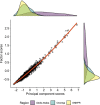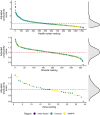A practical measure of health facility efficiency: an innovation in the application of routine health information to determine health worker productivity in Ethiopia
- PMID: 34353335
- PMCID: PMC8340541
- DOI: 10.1186/s12960-021-00636-6
A practical measure of health facility efficiency: an innovation in the application of routine health information to determine health worker productivity in Ethiopia
Abstract
Background: A simple indicator of technical efficiency, such as productivity of health workers, measured using routine health facility data, can be a practical approach that can inform initiatives to improve efficiency in low- and middle-income countries. This paper presents a proof of concept of using routine information from primary healthcare (PHC) facilities to measure health workers' productivity and its application in three regions of Ethiopia.
Methods: In four steps, we constructed a productivity measure of the health workforce of Health Centers (HCs) and demonstrated its practical application: (1) developing an analytical dataset using secondary data from health management information systems (HMIS) and human resource information system (HRIS); (2) principal component analysis and factor analysis to estimate a summary measure of output from five indicators (annual service volume of outpatient visits, family planning, first antenatal care visits, facility-based deliveries by skilled birth attendants, and children [< 1 year] with three pentavalent vaccines); (3) calculating a productivity score by combining the summary measure of outputs and the total number of health workers (input), and (4) implementing regression models to identify the determinant of productivity and ranking HCs based on their adjusted productivity score.
Results: We developed an analytical dataset of 1128 HCs; however, significant missing values and outliers were reported in the data. The principal component and factor scores developed from the five output measures were highly consistent (correlation coefficient = 0.98). We considered the factor score as the summary measure of outputs for estimating productivity. A very weak association was observed between the summary measure of output and the total number of staff. The result also highlighted a large variability in productivity across similar health facilities in Ethiopia, represented by the significant dispersion in summary measure of output occurring at similar levels of the health workers.
Conclusions: We successfully demonstrated the analytical steps to estimate health worker productivity and its practical application using HMIS and HRIS. The methodology presented in this study can be readily applied in low- and middle-income countries using widely available data-such as DHIS2-that will allow further explorations to understand the causes of technical inefficiencies in the health system.
Keywords: Efficiency; Ethiopia; Factor analysis; Health centers; Health information management system; Health personnel; Low- and middle-income countries; Primary healthcare; Productivity; Technical efficiency.
© 2021. The Author(s).
Conflict of interest statement
The authors declare that they have no competing interests.
Figures







Similar articles
-
Patient volume and quality of primary care in Ethiopia: findings from the routine health information system and the 2014 Service Provision Assessment survey.BMC Health Serv Res. 2021 May 22;21(1):485. doi: 10.1186/s12913-021-06524-y. BMC Health Serv Res. 2021. PMID: 34022856 Free PMC article.
-
Can performance-based financing improve efficiency of health centers in Ethiopia? A Malmquist Productivity Index analysis.BMC Health Serv Res. 2024 Jun 1;24(1):696. doi: 10.1186/s12913-024-11127-4. BMC Health Serv Res. 2024. PMID: 38822318 Free PMC article.
-
Level of technical efficiency and associated factors among health centers in East Gojjam Zone, Northwest Ethiopia: an application of the data envelopment analysis.BMC Health Serv Res. 2024 Mar 21;24(1):361. doi: 10.1186/s12913-024-10843-1. BMC Health Serv Res. 2024. PMID: 38515167 Free PMC article.
-
The burden of recording and reporting health data in primary health care facilities in five low- and lower-middle income countries.BMC Health Serv Res. 2021 Sep 13;21(Suppl 1):691. doi: 10.1186/s12913-021-06652-5. BMC Health Serv Res. 2021. PMID: 34511083 Free PMC article. Review.
-
The effect of antenatal care on use of institutional delivery service and postnatal care in Ethiopia: a systematic review and meta-analysis.BMC Health Serv Res. 2018 Jul 24;18(1):577. doi: 10.1186/s12913-018-3370-9. BMC Health Serv Res. 2018. PMID: 30041655 Free PMC article.
Cited by
-
Measuring and improving performance of clinicians: an application of patient-based records.BMC Health Serv Res. 2023 Jul 19;23(1):775. doi: 10.1186/s12913-023-09772-2. BMC Health Serv Res. 2023. PMID: 37468896 Free PMC article.
-
The efficiency evaluation of traditional Chinese medicine hospitals by data envelopment analysis in Zhengzhou, China.Front Public Health. 2024 Sep 4;12:1445766. doi: 10.3389/fpubh.2024.1445766. eCollection 2024. Front Public Health. 2024. PMID: 39296838 Free PMC article.
-
Costs and resource needs for primary health care in Ethiopia: evidence to inform planning and budgeting for universal health coverage.Front Public Health. 2023 Dec 19;11:1242314. doi: 10.3389/fpubh.2023.1242314. eCollection 2023. Front Public Health. 2023. PMID: 38174077 Free PMC article.
-
An assessment of economy- and transport-oriented health performance.Health Econ Rev. 2024 Oct 3;14(1):80. doi: 10.1186/s13561-024-00544-0. Health Econ Rev. 2024. PMID: 39361100 Free PMC article.
References
-
- Heller PS. Understanding fiscal space. IMF Policy Discussion Paper. 2005;19.
-
- Tandon A, Cashin C. Assessing public expenditure on health from a fiscal space perspective. Washington D.C: World Bank; 2010. http://documents1.worldbank.org/curated/en/333671468330890417/pdf/560530...
-
- Chang AY, Cowling K, Micah AE, Chapin A, Chen CS, Ikilezi G, et al. Past, present, and future of global health financing: a review of development assistance, government, out-of-pocket, and other private spending on health for 195 countries, 1995–2050. Lancet. 2019;393(10187):2233–2260. doi: 10.1016/S0140-6736(19)30841-4. - DOI - PMC - PubMed
-
- Yip W, Hafez R. Reforms for improving the efficiency of health systems: lessons from 10 country cases [Internet]. Geneva, Switzerland: World Health Organization; 2015. p. 35. Report No.: WHO/HIS/HGF/SR/15.1. https://www.who.int/health_financing/documents/synthesis_report/en/
Publication types
MeSH terms
LinkOut - more resources
Full Text Sources
Medical

